How to Write a Case Study (+10 Examples & Free Template!)
Ah, the case study: One of the most important pieces of marketing content for a business, and yet all too often, also the most boring. The problem with this is, lose a reader and you lose a customer. It doesn’t have to be this way!
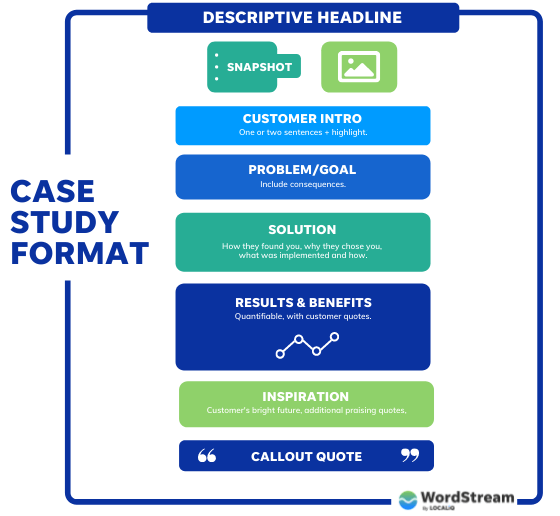
In this guide, I’m going to show you how to write a case study that prospects will actually want to read. An attractive, inspiring, and convincing case study that turns readers into customers.
Table of contents
- What is a case study?
- Why write a case study?
- How long should a case study be?
- How to write a case study: Steps & format
- An example of a case study
- Tips to write a case study that gets read
- Real case study examples
- Free case study template doc
What is a case study?
A case study is a self-contained story about how a real customer overcame their problems using your products or services. Notice how I used the word story. Marketers are obsessed with the notion of “storytelling” (usually without actually telling stories), but a good case study is a story with protagonist (your customer) who has a problem but who wins out in the end.
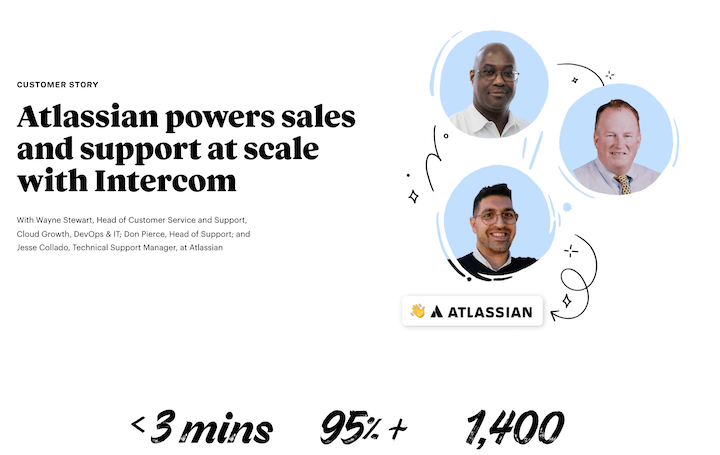
This case study example by Intercom puts faces to the name of their protagonist, Atlassian.
By the end of a case study, the reader should be able to visualize themselves as the hero of their own story. They should be able to relate to the problems of your featured customer, and see themselves achieving their own goals by using your product or service.
👀 Looking for more ways to promote your business? Download now >> 30+ Ways to Promote Your Business (On Any Budget!)
Why write a business case study?
Because they’re really effective at converting leads into customers. Here are some of the many benefits of a good case study:
- Build customer loyalty: Not only is this an opportunity to engage with your satisfied customer, but to reaffirm why they chose you and why they should continue to choose you.
- Assist sales: In addition to having case studies posted on your website, salespeople can share them with potential customers in conversations to help them build confidence in the prospect.
- Multi-purpose content: Quotes and data snippets from your case studies make great testimonial tidbits for your the homepage, products/services pages, landing pages, and more. You can also repurpose these into PDFs, videos, blog posts, and infographics.
- Earn trust: Case studies turn positive customer opinions into tangible data that actually proves your value. In fact, it’s among the most trusted content types according to 60% of marketers.
How long should a case study be?
A case study can accomplish what it needs to in a single page. Of course, case study lengths vary by industry; a kitchen remodeling business could probably tell their whole story in pictures while a software invoicing solution, not so much. But here are some guidelines to follow around case study length:
- Most resources tell you that a case study should be 500-1500 words.
- We also encourage you to have a prominent snapshot section of 100 words or less.
- The results and benefits section should take the bulk of the word count.
- Don’t use more words than you need. Let your data, images, and customers quotes do the talking.
What a marketing case study is NOT
A case study is an on-brand, data-driven, objective resource for potential customers to gain confidence in your business. Here is what they are not.
- Case studies are not press releases. Although case studies can be used to accompany new product launches, they are not merely vehicles to talk about new products. In fact, you should make your case studies as evergreen as possible so you can get the most mileage out of them.
- Case studies aren’t advertisements. Bits and pieces of cases studies can be used on landing pages or even in ad copy, but the case study itself should not be an ad. It’s not about roping in a customer or using exciting or embellishing words. It’s about sharing the facts.
- Good case studies are not about your company. They’re about the customer’s journey. Most case studies are bland, instantly forgettable crap because marketers ignore the fact that case studies are stories in the most literal sense. They get preoccupied with things like brand voice or messaging matrices and forget to leverage the narrative form that makes stories so compelling. Or, even worse, they simply can’t stop themselves from harping on about how great their company is, the gravest of sins when case studies are concerned.
How to write a case study: steps & format
Now that we’re clear on what a marketing case study is (and isn’t), as well as why you should be producing them, let’s talk about how to actually write a case study worth reading. The elements of a case study include:
- Clear headline: Like a newspaper headline, it should give the most important information. A subtitle with supporting details or a customer quote is optional.
- Snapshot: Provide the TLDR prominently at the top, including the client’s name/industry, the product/service used, and quick result stats.
- Client introduction: One or two sentences describing the customer and a highlight about them.
- Problem: State the problem/goal, consequences, and any hesitations the customer had. Include quotes.
- Solution: Share how they found you, why they chose you, what solution they chose, and how it was implemented. Include quotes.
- Results: Describe the results and the benefits, as well as any bonus benefits that came of it. Include quotes.
- Conclusion: Share additional praise from the customer and words of advice they have for other people/businesses like them.

🛑 Get the free guide >> PPC 101: Complete Guide to Google Ads
A case study example
Let’s go into the details on each one of the steps above, using a fictional example. Our business is Kumbo Digital and our client is Currigate.
1. Start with a clear headline
This should be like a newspaper headline that gives the most important information. A subtitle with supporting details or a customer quote is optional.
Currigate Plugs $12k in Profit Leaks with Kumbo Digital
2. Provide a snapshot
There should be a section at the top with the important details. This includes
- Customer name/category/industry
- Product/service used
- Results (ideally three stats)
3. Introduce the client
Share one to two sentences with your customer’s name, industry, location, and a highlight.
Currigate is a software service that offers highly customizable subscription packages to banks, brokers, and investors in the mortgage lending market.
4. State the problem, consequences, & hesitations
Explain the issue the customer was facing or the goal they were having a hard time reaching—as well as the negative outcomes.
While this high level of customization is what sets Currigate apart from its competitors, it also requires multiple applications with disparate data and heavy manual work. Account owners were spending so much time manage invoicing, there was little left over to build relationships with clients, stay on top of overages, and upsell. This was leading to leaks in profitability and a weakening of customer service.
Include customer quotes as well as any hesitancies they had with using a product or service like yours.
“We were getting in our own way,” said Melanie Grigham, Currigate’s VP of Operations. “Our customer relationships were starting to falter, and we knew we had to do something. But the thought of manipulating just one of our data sources—let alone all seven—was scary. There were so many random connections in place and so much confidential information, we couldn’t risk it all breaking.”
5. Describe the solution
Share how the customer found your business and why they chose you.
Grigham learned about Kumbo Digital through none other than Google research and decided to get in touch. “The thought of explaining the whole thing felt daunting, but I was relieved to hear [the rep] finishing my sentences for me!”
Include which specific product or service they chose, how it was implemented, and how the customer used it. Stay brief!
After learning the details of the situation, the Kumbo team proposed a custom solution that would integrate all of the data sources into one dashboard. “I was hesitant at first, but they showed me a small scale example which helped me to understand a little more about how it would work. I appreciated their patience with me as I took some time to make a decision.”
Grigham finally went with it. The dashboard took three weeks to implement and the data migration took just under a day.
6. Share the results & benefits
Share how the client used your product/service, what the results were, and the benefits. Include direct quotes and clear evidence (statistical data, before-and-after images, time-lapse videos, etc.)
With the new platform, Currigate’s account managers could access all seven data sources—as well as generate, track, send, and approve invoices—all in one place. Time spent invoicing went from days to hours, freeing up time for them to engage with customers and work toward strategic goals. “Our staff are less bogged down to the point where they’re asking to take on more clients—which is unheard of.”
The redesigned and simplified product catalog (206 product codes instead of 1,024) has also made it easier for them to upsell as well as recommend combinations for specific needs. “Sometimes our new clients don’t know what they want, and this is perfect for giving them a starting point.”
In addition, Currigate was able to identify $12,403 worth of overages they wouldn’t have caught otherwise. “Now, we can be sure that their customers are being billed appropriately (which is great for us) and receiving the services best fit for their dynamic needs (which is great for them). It’s a win-win.”
7. Conclude with words of advice and a CTA
Share where the client is headed, any additional quotes or praise, and/or their advice for similar potential clients.
Today, Currigate’s unique subscription model is as strong as ever. It’s even considering opening up to new markets. “We never thought we’d reach this point so soon—we thought new markets was years down the line,” said Melanie. When asked what advice she had for other businesses like hers, she talked about mixing faith and facts. “You’ve got to do your research to find a trusted provider, but at the end of the day, it all comes down to a leap of faith, and sometimes you just have to do it.”
Finish off with a CTA to contact your business and/or a link to view more case studies.
📚 Free guide download >> The 36 Best Call to Action Phrases Ever (& Why They Work)
Tips on how to write a case study that prospects will want to read
Alright, so that was a basic example of a case study, but there’s more to it than just the words that comprise it. Here are eight tips to write a great case study that prospects will want to read and that will help close deals.
1. Make it as easy as possible for the client
Just like when asking for reviews, it’s important to make the process as clear and easy as possible for the client. When you reach out, ask if you can use their story of achievement as a case study for your business.
Make the details as clear as possible, including:
- The process (20 minute interview, follow up with a draft for their approval).
- Where the case study will live (on your website? in PDFs shared by sales reps? etc.)
- Their options for the interview (in person, phone/video call, via email).
- Any benefits (exposure on social, for example).
The clearer the picture you paint for them, the more receptive they’ll be to sharing their time with you.
2. Include a prominent snapshot with the results
While a good case study is like a story, you don’t want to hold out on your reader until the end. You want them to know the results right off the bat, then they can read further to find out how those results were achieved. In the example below, the overall picture is made clear with the title (The Loot Box Uses Ad Factory and Content Marketing to Drive Sales) and the three stats below it.
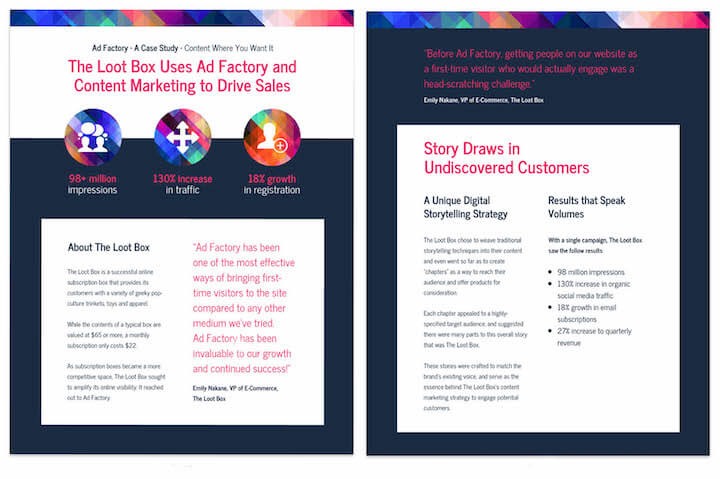
3. Choose an interesting angle
Apart from kitchen remodeling and website makeovers, it can be hard to make a case study compelling. But there is always room for creativity.
- Focus on particularly interesting customers who use your product in a unique way or who have a more extreme situation.
- Weave a theme into the story that connects your industry with theirs (this might mean puns).
- Hook the reader at the beginning with a teaser about the best result in the study.
- Incorporate the client’s unique personality into the story.
The more compelling your angle, the better the story. The better the story, the more engaging your case study will be. In Mailchimp’s case study example below, the customer name (Good Dye Young), compelling headline, and expressive image all work together to give this case study life.

4. But make it relatable to all prospects
Your angle is the “hook” that will catch your audience’s attention, but it’s essential that ALL prospects can relate to and identify with the problems encountered by your case study’s “protagonist.” This means catering to your core demographics and target markets, and solving the problems most commonly experienced by your customers.
The same Mailchimp case study example above finishes off with an “advice for other small businesses” section:
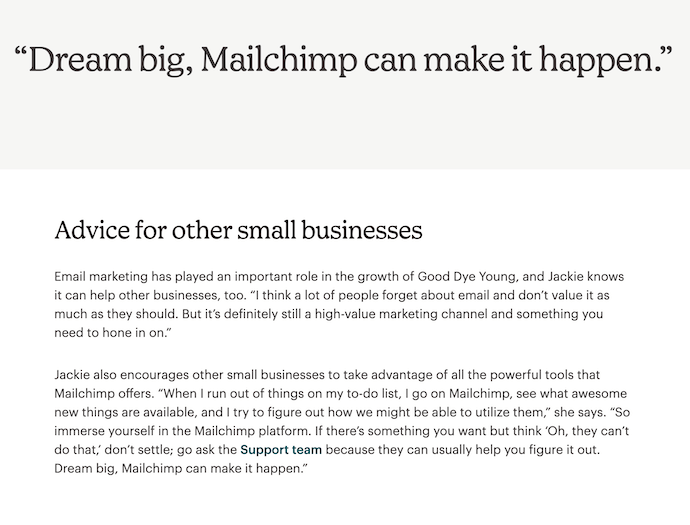
5. Make them visually appealing (and consistent)
We already know that case studies aren’t the most exciting reads, so don’t make it worse by throwing a bunch of text and numbers onto a page. A good case study is skimmable, visual, and organized.
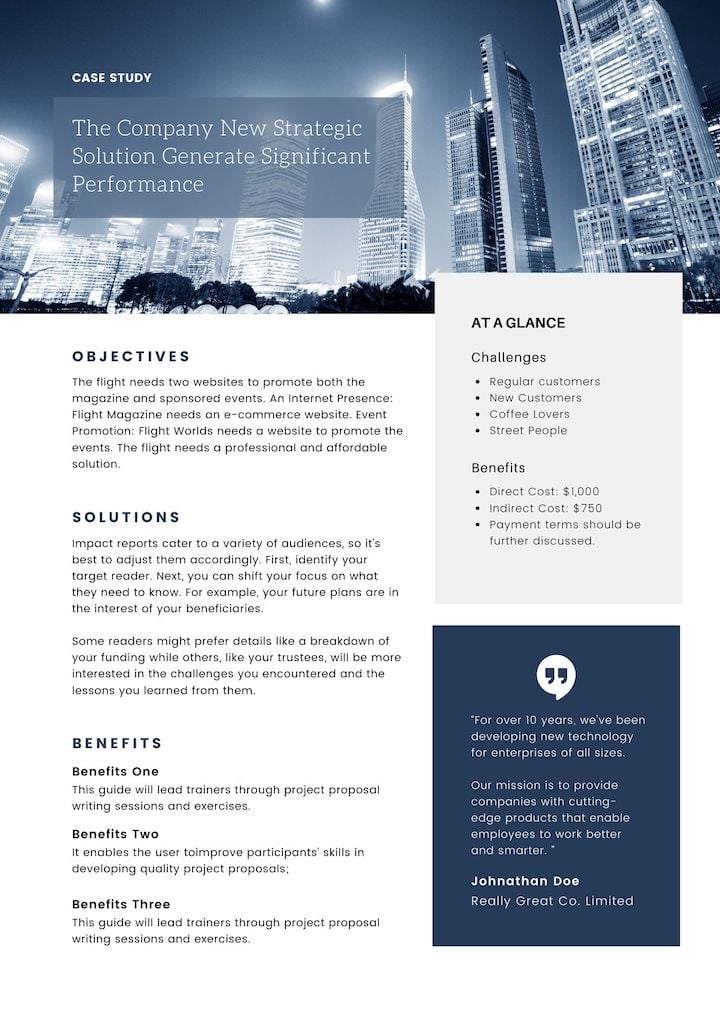
The case study is clean, organized, and skimmable.
Whatever format you go with, use it for all of your case studies. This will not only help you to streamline the process but also make it easier for prospects to digest the information.
6. Be the supporting character, not the hero
Your company should always be positioned as a helping hand that helped the real hero of the story—your client—overcome their obstacle. There are two reasons this approach is so effective. Firstly, you want your audience to visualize themselves as the protagonist of the case study. This is much more difficult if you won’t stop talking about how great your company or product is. Secondly, adopting a more humble tone can help increase your credibility in the mind of the reader.
Notice for all of these Shopify case studies, the client is the hero of the story.
- Allbird’s omnichannel conversions soared
- Gymshark scaled internationally
- Staples replatformed in half the time
- Bombas saved $108,000 a year
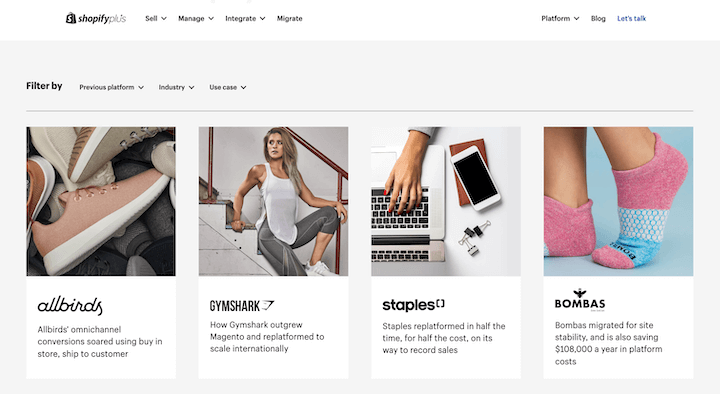
7. Let your clients tell their own story
As a storyteller, it’s your job to craft a compelling narrative about how your featured client triumphed over the forces of evil using your product or service, but that doesn’t mean your protagonist doesn’t have their own voice.
Let them tell the story in their own words and then incorporate direct quotes into your narrative. This will break up your text, increase credibility, and make your protagonist a tangible character that readers can relate to. Take an interview style format and use paraphrasing and annotations so the text isn’t repetitive. Set up the segue and create room for your client’s quote, and let them do the rest.
View the full case study example here.
8. Have realistic expectations
Yes, we want to create a useful, helpful resource for prospective customers, but let’s be real—nobody’s winning a Pulitzer for a case study, and it won’t be going viral on social media, no matter how well-written it is.
Case studies are little more than tools to be used by either self-motivated prospects researching your company, or by sales professionals as tools to help convince prospects to convert. Nothing more. They’re designed for audiences that are already strongly considering becoming your customers, which is a smaller but more qualified group of people than your general audience.
So don’t be disheartened if your case study content doesn’t attract as much traffic or engagement as your best or even average content. They’re not meant to. But that doesn’t mean you should stop creating them or start obsessing over how to improve them.
Business case study examples
Here are some business case study examples that put the tips in this guide into play.
LOCALiQ
Call us biased, but LOCALiQ’s case study format is pretty rad. What we like about it:
- High-quality visual at the top.
- Immediate snapshot of customer and results.
- Clear-cut sections with challenges, solutions, and results.
- Customer quotes layered in with paraphrasing and commentary.
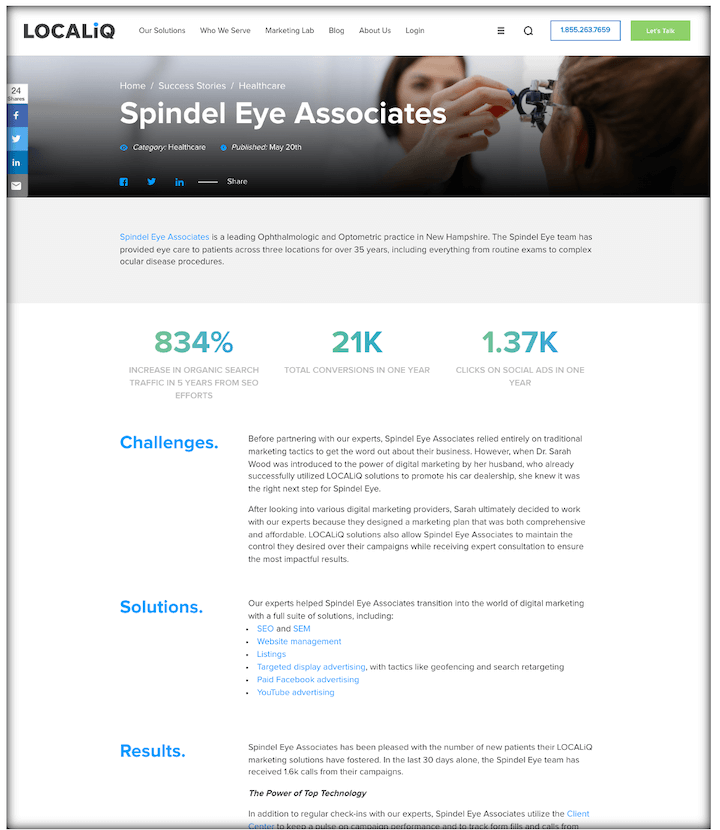
Intercom
You saw a sneak peek of this above! What we like about it:
- Special care given to give the client a face and a glowing description.
- Nice mix of real images with graphics (one of our landing page design trends).
- Newspaper headline approach (with a rhyme!): Atlassian powers sales with support at scale with Intercom
- Prominent data results
- Snapshot sidebar on the left with client information and features used.
Mailchimp
After the “Good Dye Young” example earlier, how could we not include another Mailchimp case study? What we like about it:
- Compelling headline: How Stretch & Flex Started and Grew During a Pandemic
- How the subtitle aids in the TLDR: Surveys helped the virtual Pilates studio make quick adjustments and plan for long‑term success.
- Colorful, expressive images and clean snapshot.
- Alternating background colors to distinguish the quotes and stats—the best parts of the story, of course.
- Conclusion with advice to small businesses.
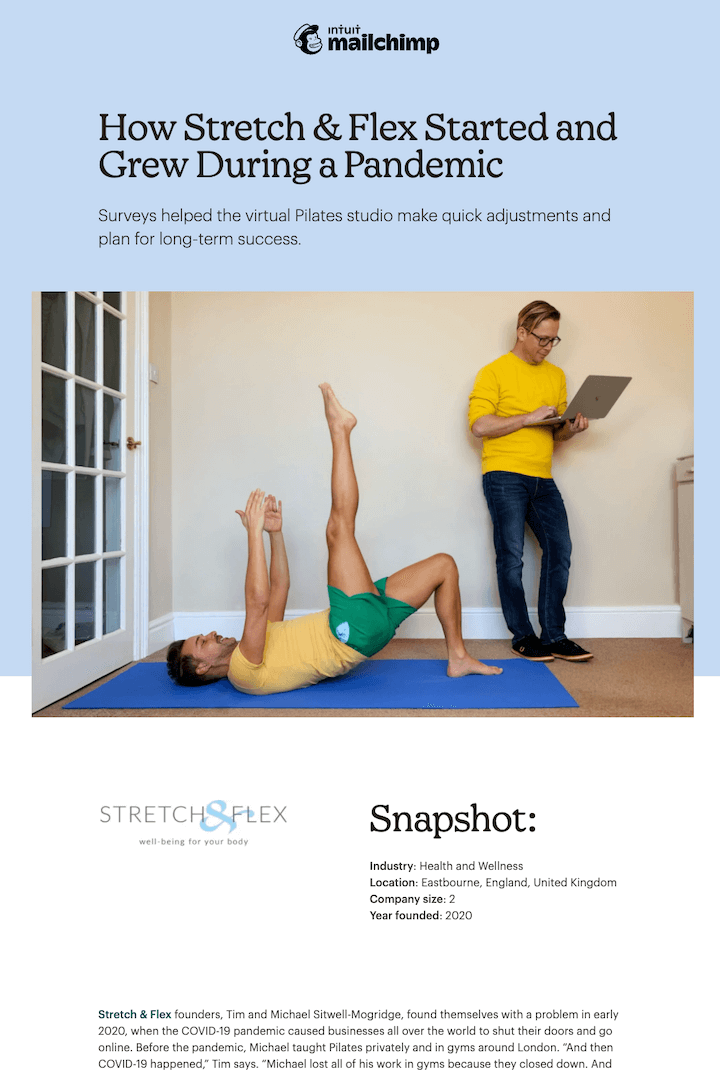
Wrike
Wrike takes the case study snapshot to the next level in this example. What we like about it:
- Puts a face to the name of the client, just like Intercom does.
- Nice mix of photos and graphics together (like Intercom).
- Mega snapshot that basically gives you all of the information you need.
- Bright green result data.
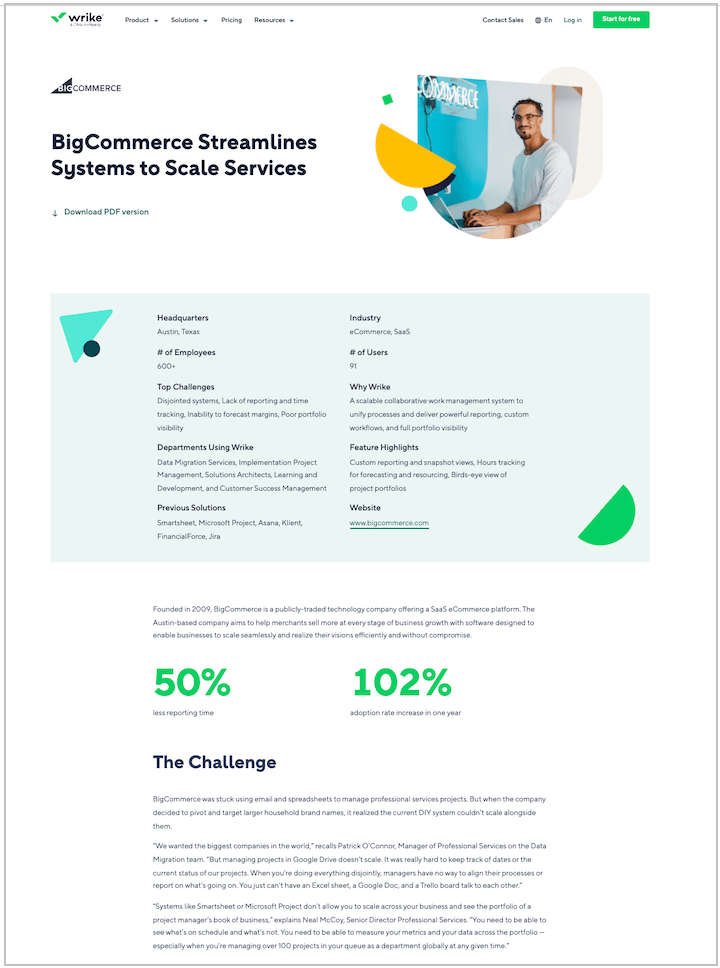
Slintel
Our final marketing case study example comes from Slintel, a go-to-market intelligence software. What we like about it:
- Attractive headline: Leoforce sees 2x increase in meetings booked with Slintel
- Coordination of image with branding colors.
- That it is written by their RevOps manager (what is RevOps?).
- Descriptive headings: The Challenge: Cleaning up bad data.
- Large results data and prominent quote callout boxes.
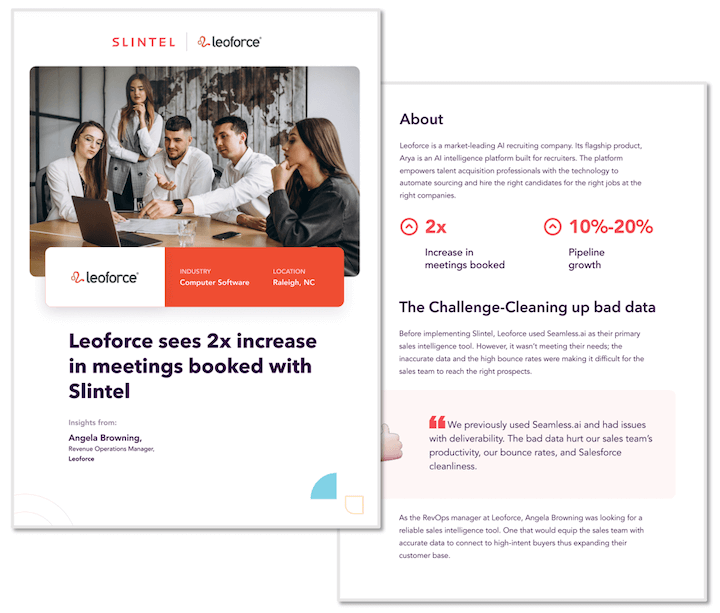
Marketing case study templates
To make things easy for you, I’ve compiled the tips and examples into a marketing case study template, in document form, that you can use to write your own.
- WordStream’s case study template doc: All the steps in this guide compiled into this case study Google Doc template to make your life much easier.
- Canva case study templates: Canva has a number of free case study templates (the one in tip #5 is one of them!) that look professional and polished.
- Visme’s case study templates: With a free login, you can access and customize some of Visme’s case study templates.
- Storydoc’s case study templates and design tips: Use Storydoc’s case study templates to create and customize a great story with a 14-day free trial.
Use these case study examples & tips to get started with your own
No two businesses are alike, and case studies vary widely in terms of style, tone, and format. One thing that all marketing case studies share, however, is their purpose – to convince prospects that doing business with you is a good idea. With these case study steps, tips, examples, and templates, you’ll be well on your way to producing stories your prospects will actually want to read.

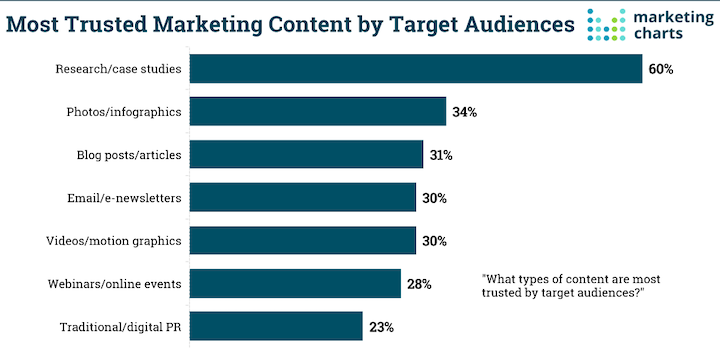
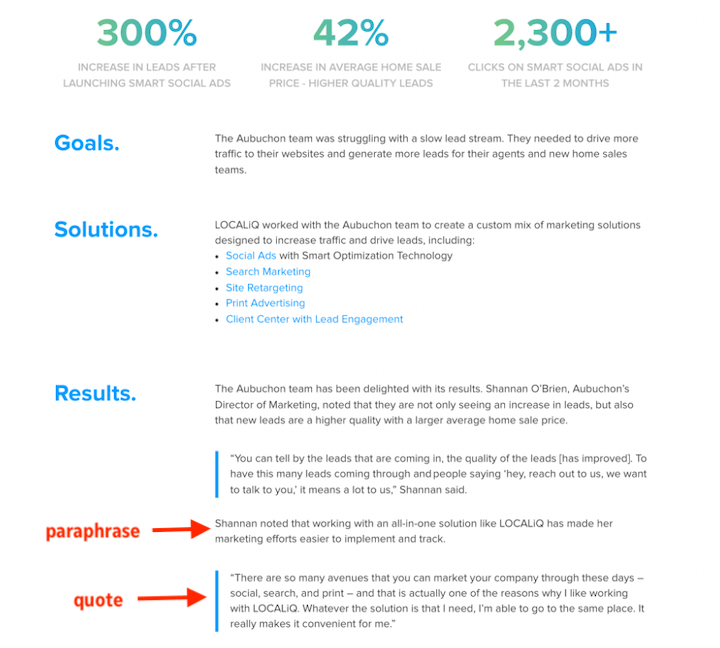
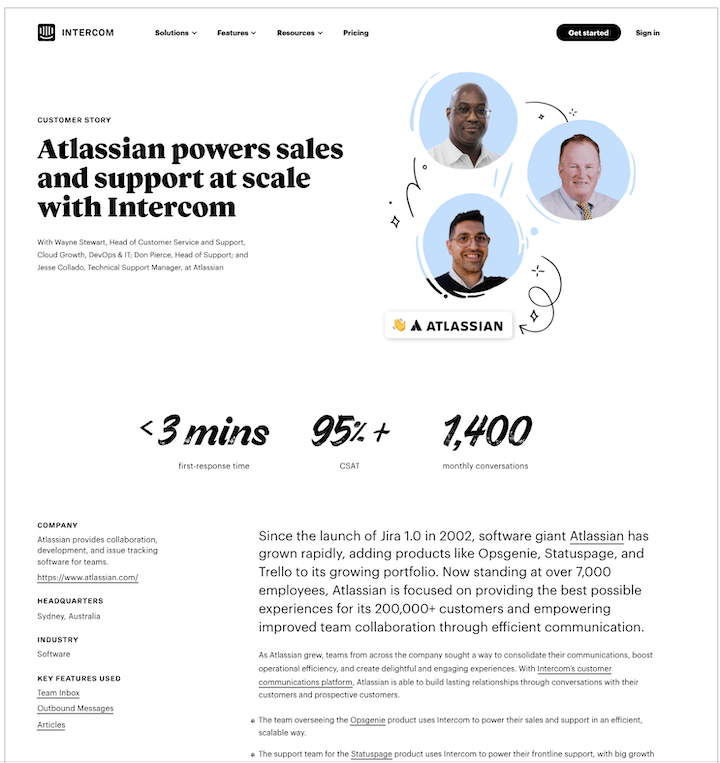








Comments
Please read our Comment Policy before commenting.